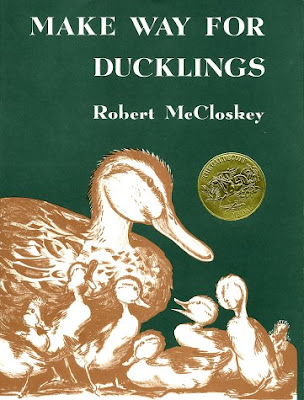Boston's Public Garden is a rectangle bounded by Beacon, Charles, Boylston, and Arlington streets, and there's a fascinating sculpture on the north-east corner of it. On the face of it, this post seems to smack of that awful animal, you know, the t-word: tourism. How many tourists in Boston stop to sit their kids on the ducks and take photos? Isn't this post about the p-word too? Yes: popularity!
So what possible defense could I make for this post? Well, this attaction is free, it doesn't cost about $50 dollars like the Boston CityPASS which droves of tourists buy to see a number of things they probably don't really want to see. Plus it's literature: this delightful culpture is based on a Boston book, but unlike such Boston books as The Bostonians, or Looking Backward, or Infinite Jest, or Laura Warholic, or any other book set in Boston, this one's for children. Of all ages. Make Way for Ducklings, by Robert McCloskey (1914—2003), was his second book and was published in 1941. It has sold over 2,000,000 copies, although I wonder how many of those were in the States alone. But it can certainly be called obscure in the UK: searching for the title in local libraries has proved fruitless, and Humphrey Carpenter and Mari Prichard's two column inch entry on McCloskey in The Oxford Companion to Children's Literature (1999, p. 327 ) expresses regret that very few of his books are available in the UK.
There is little text in the book, which an adult could easily read in a few minutes, but McCloskey's illustrations are bigger, and he studied ducklings to the point of keeping several of them in his studio in NYC.
The story is about a couple of mallards who fly around central Boston in search of a place to start a family. At first they're happy with the pond in the Public Garden, where people throw them peanuts from the swan boats, but a bicycle frightens Mrs Mallard so they find a nearby island on the Charles River. Mrs Mallard gives birth to eight ducklings: Jack, Kack, Lack, Mack, Nack, Ouac, Pack, and Quack. Policeman Michael feeds the family peanuts from the river bank.
Mr Mallard decides to investigate downstream while Mrs Mallard prepares the ducklings for the real world, and the couple agree that they should all meet at the Public Garden a week later.
When it comes to the time to leave, the ducks have a traffic problem, as they have to waddle across Embankment Road and down Mount Vernon and Charles streets to enter the park. Michael comes to the rescue by getting the police to stop the traffic as they make their way to the Public Garden where Mr Mallard is waiting, and where they decide to stay.
The ending is difficult to believe, as drakes are sexually promiscuous, and the idea of Mr Mallard being there after a week is of course an example of anthropomorphism. But it makes a good story, and one that has endured.
'THIS SCULPTURE HAS
BEEN PLACED HERE AS A TRIBUTE TO
ROBERT McCLOSKEY,
WHOSE STORY "MAKE WAY FOR DUCKLINGS"
HAS MADE THE BOSTON PUBLIC GARDEN
FAMILIAR TO CHILDREN THROUGHOUT THE WORLD
1987'
Oddly, there is no mention of the artist, but this bronze structure was made by Nancy Schön, who unsurprisingly chose to depict the troop of ducklings as they are waddling along the sidewalk, a piece of which is incorporated in the work itself. And, of course, there is no Mr Mallard. I had to wait a short time before all the kids clambered off the ducks, but an obliging couple of young women let me get on with the job without interfering.
Mrs Mallard with, as the book repeatedly choruses,
Jack,
Kack,
Lack,
Mack,
Nack,
Ouac,
Pack,
And Quack!
In 1991 the First Lady Barbara Bush gave a copy of the statue to the Soviet First Lady Raisa Gorbachev for the children of her country, and it was erected in Novodevichy Park in Moscow the same year.




2 comments:
Cute!
KACK is awesome!
Post a Comment